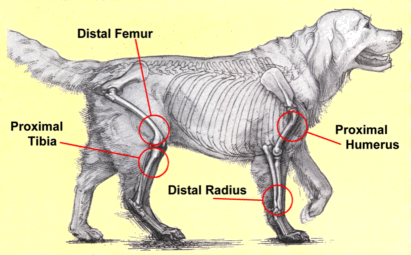Osteosarcoma (bone cancer) is somewhat rare, accounting for approximately 5% of all canine and feline tumors however is the most common form of bone tumor in either species.
Forming primarily on the knee, hip, and shoulder bones, osteosarcoma is a malignant tumor that may develop in any bone and can be aggressive, developing rapidly. In cases of highly aggressive tumors, over 90% of all clinically significant osteosarcomas have already metastasized by the time of diagnosis, spreading to the lungs, liver and/or other bones. This disease usually occurs in middle aged or elderly cats and dogs.

Osteosarcoma In Dogs
Osteosarcoma typically affects middle-aged, large breed dogs. Some breeds are more predisposed to the disease than others, such as Irish Wolfhounds, Greyhounds, German Shephards, Rottweilders, Doberman Pinschers, Great Danes and various mountain breeds. There are some studies which suggest that heredity may play a part as well.
Osteosarcoma is more than 10 times more common in dogs than in humans.
Osteosarcoma In Cats
Less aggressive in cats than dogs, Osteosarcoma tumors typically affects the rear legs. Because it is less aggressive cancer in cats, amputation is a common treatment. DCA can be effective as a follow-up treatment to ensure no additional tumors or cells have been missed.
Osteosarcoma In Humans
While cancers in humans isn’t usually mentioned here, some famous people have been affected by this disease such as Wayman Tisdale, Bruce Feiler, Chiara Badano, and Edward M. Kennedy, Jr. Most notably was Terry Fox (1958-1981) who was a Canadian humanitarian and cancer activist. Fox began a famous run across Canada for cancer research after developing osteosarcoma as a teenage and had his right leg amputated.
Osteosarcoma Symptoms
Osteosarcoma develops tumors deep within the bone, which eventually grows to cover the top of the bone. Once the disease progresses, pets can experience a great deal of pain and discomfort in their joints when walking or running. The main symptom of osteosarcoma is lameness, with or without noticeable swelling or mass at the tumor site.
A tumorous bone is weaker than healthy bones and is more likely to break (pathologic fracture) with minor injury and will not heal.
Obvious symptoms of osteosarcoma are difficult to identify until the disease has progressed to more advanced stages. Early warning signs are generally “signs of pain” which may include; panting, lameness, difficulty sleeping, pacing, abnormal posture, body tensing, poor grooming habits, tucked tail between legs, dilated pupils, licking sore areas, muscle atrophy, decreased appetite, vocalizing/yowling, reclusive behavior, aggressive behavior, avoiding stairs/jumping/exercise, depression, difficulty moving, difficulty standing.
Osteosarcoma Diagnosis
Diagnosis of osteosarcoma in cats and dogs is generally initiated with a complete orthopedic and neurological examination, physical examination, and regional X-rays. A definite diagnosis can be achieved when a bone biopsy, followed by chest X-rays to see if the tumor has spread to the liver or lungs. The biopsy will confirm whether or not the tumor is benign or malignant.
Osteosarcoma Treatments
Amputation of the leg is usually the initial treatment however this alone does not prevent metastasis. Chemotherapy, combined with amputation and DCA can improve the survival time and chance of full recovery.
Comments are closed.